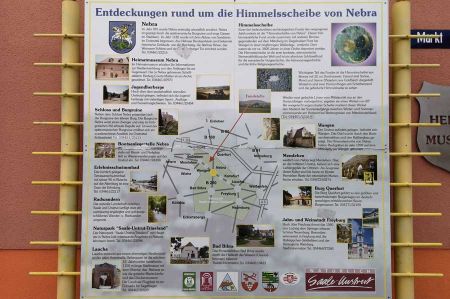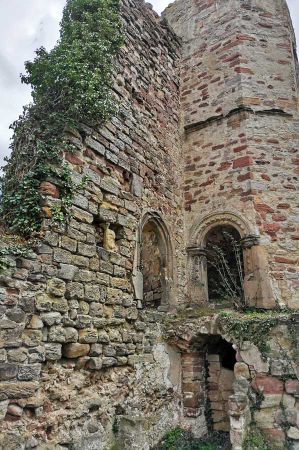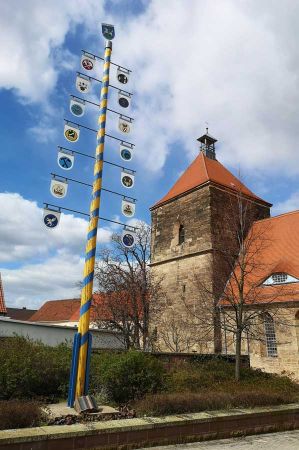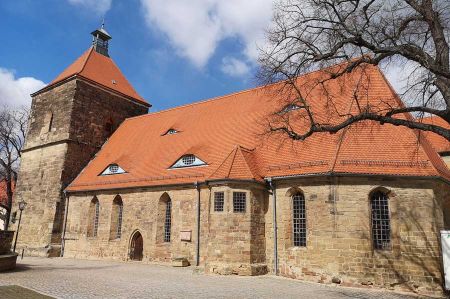Nebra – ancient sky disk and yet hardly any revival?
- Written by Portal Editor
Who of us has not heard the name Nebra at least once? Since the discovery of the ancient Nebra Sky Disc, which has long been legendary already, the name has surely been known to many.
We were on the way to Nebra due to an important appointment, sometimes even in times of “Corona” crisis necessary. And in order to get to know the surrounding area a little more with regard to the approaching spring and the hopefully enjoyable bike tours, we had chosen the route from Finneland to Kaiserpfalz, then through the valley of the Unstrut River, the name of the cycle path running here, in our heads. The Unstrut bike path leads through a landscape with half-timbered houses, historical castles, palaces, monasteries, medieval fortifications, agriculture and nature reserves. It connects the federal states of Thuringia and Saxony-Anhalt over almost 200 kilometres.
Through the valley of the Unstrut - red sandstone accompanying
 While driving along the Unstrut, the partially deep cuts in the sandstone of the valley were visible to the naked eye, which also extends into the side valleys. Red and salmon-coloured Nebra sandstone has been mined on the slopes of the Unstrut for many centuries. The sandstone was used as building material, for farmhouses but also for castles and other representative buildings such as the Brandenburg Gate in Berlin. Mining here in the region only came to a halt in the 20th century.
While driving along the Unstrut, the partially deep cuts in the sandstone of the valley were visible to the naked eye, which also extends into the side valleys. Red and salmon-coloured Nebra sandstone has been mined on the slopes of the Unstrut for many centuries. The sandstone was used as building material, for farmhouses but also for castles and other representative buildings such as the Brandenburg Gate in Berlin. Mining here in the region only came to a halt in the 20th century.
Very close to Nebra on the Altenburg, one of the coloured sandstone spurs in the Unstruttal valley, four Venus figures from the late Young Paleolithic (Magdalenian) were found in 1962 and are among the oldest known works of art in Saxony-Anhalt. The figurines are 12,000 to 14,000 years old. They are exhibited today in the State Museum of Prehistory in Halle.
Nebra - an almost lifeless small town despite the sky disk
 We drive to the centre of the small town, which seems extremely lifeless, not at least because of the immensely high vacancies in buildings. Sights include the ruined castle and the Hedwig-Courths-Mahler archive in the Nebra local history museum with an exhibition on the Nebra sky disk and the Bronze Age, of course currently closed. Striking for us, the numerous apartment buildings with their Renaissance portals that are absolutely worth seeing, but also vacancy here.
We drive to the centre of the small town, which seems extremely lifeless, not at least because of the immensely high vacancies in buildings. Sights include the ruined castle and the Hedwig-Courths-Mahler archive in the Nebra local history museum with an exhibition on the Nebra sky disk and the Bronze Age, of course currently closed. Striking for us, the numerous apartment buildings with their Renaissance portals that are absolutely worth seeing, but also vacancy here.
Everything seemed to change when on July 4, 1999 the so-called Nebra Sky Disc was excavated on the Mittelberg along with a bronze treasure of two predators. The sky disk comes from the immediate vicinity of Nebra (Wangens) and is considered the earliest known representation of the sky in human history. It was built around 1600 BC while manufacturing dates from 2100 to 1700 BC is estimated.
The Nebra Sky Disc shows the world's oldest known concrete representation of the cosmos and is a unique testimony to human history. The 3600 year old round bronze disc measures 32 cm in diameter and shows the sun - depending on the interpretation also the full moon -, a crescent moon and a total of 32 golden stars. Seven of them stand close together and are interpreted as the constellation of the Pleiades.
 Marginally there are so-called horizon arches added to the sky disk at a later point in time as well as a ship depiction that is interpreted as a »sun barque« as a mythical element on the bronze disk. The edge of the sky disk was later perforated. One of the horizon arches was removed or lost.
Marginally there are so-called horizon arches added to the sky disk at a later point in time as well as a ship depiction that is interpreted as a »sun barque« as a mythical element on the bronze disk. The edge of the sky disk was later perforated. One of the horizon arches was removed or lost.
On June 20, 2007, a multimedia visitor centre called Arche Nebra was opened near the location of the sky disk near Nebra. Part of the system is a 30 m high observation tower inclined by 10°, which is divided into two parts with a vertical section. At the summer solstice, it marks the axis of sight to the Brocken as the pointer of an oversized sundial.
And despite the investments as an interesting destination for travellers, is there so much vacancy and little movement on the streets? All because of Corona, certainly not! In the centre of town there was still a highlight: a “mom and pop shop” in large format, in other words a shop with an incredible inventory, from wooden money boxes to toothpaste and shoelaces, everything in the range.
Please read as well:
Royal Art and Freemasonry - Encouter in Vienna
Rewa Fishermann - boatmen from the fishing village
-
 Nebra - A hike through the village centre
Nebra - A hike through the village centre
Nebra - A hike through the village centre
Nebra - A hike through the village centre
-
 Nebra - A hike through the village centre
Nebra - A hike through the village centre
Nebra - A hike through the village centre
Nebra - A hike through the village centre
-
 Nebra - A hike through the village centre
Nebra - A hike through the village centre
Nebra - A hike through the village centre
Nebra - A hike through the village centre
-
 Nebra - A hike through the village centre
Nebra - A hike through the village centre
Nebra - A hike through the village centre
Nebra - A hike through the village centre
-
 Nebra - A hike through the village centre
Nebra - A hike through the village centre
Nebra - A hike through the village centre
Nebra - A hike through the village centre
-
 Nebra - A hike through the village centre
Nebra - A hike through the village centre
Nebra - A hike through the village centre
Nebra - A hike through the village centre
-
 Nebra - A hike through the village centre
Nebra - A hike through the village centre
Nebra - A hike through the village centre
Nebra - A hike through the village centre
-
 Nebra - A hike through the village centre
Nebra - A hike through the village centre
Nebra - A hike through the village centre
Nebra - A hike through the village centre
-
 Nebra - A hike through the village centre
Nebra - A hike through the village centre
Nebra - A hike through the village centre
Nebra - A hike through the village centre
https://www.alaturka.info/en/germany/saxony-anhalt/5053-nebra-ancient-sky-disk-and-yet-hardly-any-revival#sigProId5c61c4c6f7

